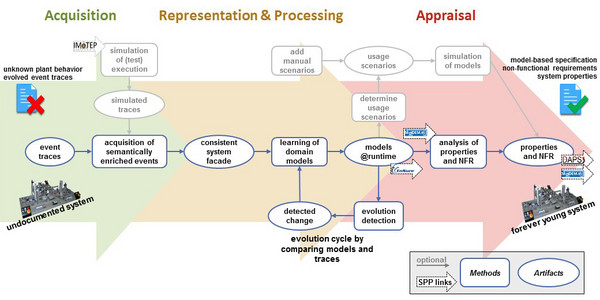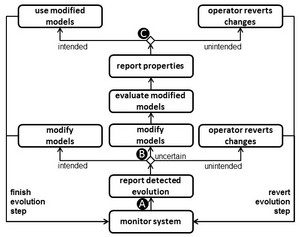The FYPA²C Approach
The FYPA²C project established an evolution support process which follows the idea of establishing a so called “Anti-Aging Cycle” for production systems. This Anti-Aging Cycle tries to glue the system behavior and system properties regarding non-functional requirements together by constantly comparing system behavior with models acquired at runtime.The process consists of three parts, namely acquisition, representation and processing, as well as appraisal of knowledge.
The knowledge acquisition is based on monitoring events of externally observable signals in event traces during runtime. As known from knowledge management, data (the recorded event traces) can be lifted to knowledge (the required process properties). In order to do so, event traces are enriched by linking the monitored signals with simple semantic annotations to represent an enriched information base for a model generation and interpretation.
Further abstraction is achieved in the representation part by using so called knowledge models. Each of these models represents specific aspects of the monitored system in runtime artefacts. Models are learned from event traces by suitable domain specific learning algorithms in the processing part. These algorithms bring the provided enriched information into relationships and, therefore, allow for reasoning at a more abstract level. The learned models are used to detect evolutionary changes by comparing runtime event traces with the knowledge models.
To give a valuable evaluation support of the detected evolution, the appraisal part raises the abstraction level by automatically analyzing the knowledge models regarding typical system properties of interest. Both, the analysis results as well as the detected changes, are presented to the operator. These high-level properties can then be evaluated even by non-technical staff (e.g. the plant manager) in order to initialize anti-aging countermeasures.

- Evolution Support Process of the FYPA²C project
Supporting Operators during Evolution

- Semi-automated decision support process
Since a monitoring system cannot easily decide if a performed change and its influences on the properties is intended (or acceptable), the FYPA²C project developed a semi-automated decision process with a human in the loop. In the process as shown bellow, first the anomaly detection indicates that an evolutionary change occurred whenever an observed behavior contradicts the knowledge models (“A”). This anomaly is, in a first step, reported to the operator. At this point only the actual anomaly, the model part it occurs in, and a limited amount of information related to the model information view can be reported. Deductions on the overall impact on requirements are very restricted here. Therefore, if the operator cannot make a decision based on this first information (“B”), the changed behavior is added to the concerned knowledge models in order to evaluate the effects on the system properties in detail. This is done by an analysis based on the models of the evolved plant in which properties related to the process are extracted out of the model behavior and structure. Here, a simulation of knowledge models widens the available information by simulating the now adapted post-evolution models for pre-evolution observed usage scenarios. The advantage of the (simulated) analysis is that the operator can be informed about the evolution based on the changed overall properties of the system. As a reaction, unintended evolution steps can be reverted or, in case of an intended evolution step, the adapted knowledge artefacts can be confirmed as valid (“C”).